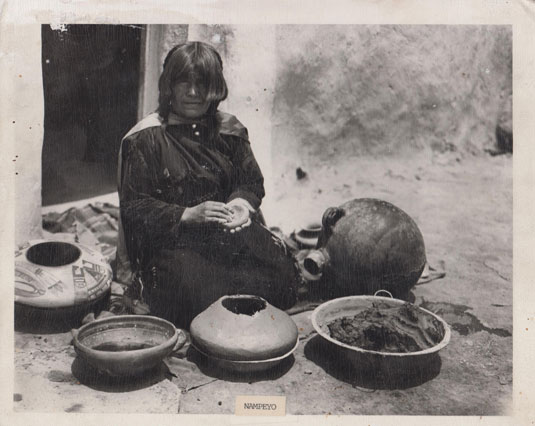Hopi Pueblo Polacca-Style Polychrome Pottery Bowl by Nampeyo of Hano [SOLD]
+ Add to my watchlist Forward to Friend
- Category: Historic
- Origin: Hopi Pueblo, Hopituh Shi-nu-mu
- Medium: clay
- Size: 10-1/4" diameter x 3-3/4" deep
- Item # C3304 SOLD

This is a very important early example of Hopi Pueblo pottery by Nampeyo before she became famous for the Sikyatki Revival wares. There is little, if any, documented Nampeyo pieces prior to her becoming famous around circa 1900.
This bowl was inspired by one in the Peabody Collection. It is pictured on page 317 of Historic Hopi Ceramics-The Thomas V. Keam Collection of the Peabody Museum of Archaeology and Ethnology, Harvard University, by Wade and McChesney. The Keam Collection was purchased for $10,000 by Jesse Walter Fewkes as supplemental to the collection amassed during 1891-1892 under the auspices of the Hemenway Expedition which was being funded by Mrs. Mary Hemenway of Boston. When she passed away in 1894, the expedition was terminated and the collection was given to the Peabody.
The bowl that inspired Nampeyo to make this one is documented as Keam Collection No. 1002 and the Peabody Collection No. 42-39-10/25432.
Most likely, Nampeyo saw the bowl at Keam's store before it was sold to the Hemenway Expedition and she was inspired to create her version. It is obvious Nampeyo's bowl was influenced by the Keam bowl. Note: click on the second detail image link to view the page of the book of the Peabody Collection and compare for yourself (or click here).
In the 1900 federal census, only Nampeyo and one other woman called themselves "potters." (Kramer, p.34). We know, according to Fewkes, that Nampeyo began to "cleverly imitate" Sikyatki ware as early as 1895. Based on this, I believe some of the pieces she made from Polacca wares predated those made from Sikyatki wares and were as early as 1890.
"Designs borrowed by Nampeyo from Sikyatki ware constituted only one of many prehistoric periods incorporated by the potter." (Kramer, p.160). This is another indication that she did not only borrow from Sikyatki pottery, but perhaps from Polacca, too.
The Nampeyo bowl is slipped with a non-crazing white kaolin slip as opposed to the typical crazing seen in the slip of Polacca wares. This eliminates the possibility that this could be Polacca rather than Nampeyo.
This bowl by Nampeyo conforms to the lower profile of her "Golden Age" bowls as described by the Blaire's in The Legacy of a Master Potter, p. 90.
While Sikyatki designs are far more common in Nampeyo pieces, examples of Polacca designs on her pottery are far more rare.

Condition: The condition of this Hopi Pueblo Polacca-Style Polychrome Pottery Bowl by Nampeyo of Hano is extraordinary considering its age. There has been some abrasion and some minor paint loss at the rim, but no other damage. There has been no restoration, repair or over-paint.
Provenance: previously from a collection of Nampeyo pottery from La Mesa, California. Now from the estate of the client to whom we sold it in 2006. A letter of attribution by Dr. Edwin L. Wade is also included with the purchase of this bowl.
References:
- Kramer, Barbara. Nampeyo and Her Pottery. The University of Arizona Press. Tucson. 1996.
- Blair, Mary Ellen and Laurence. The Legacy of a Master Potter; Nampeyo and Her Descendants. Treasure Chest Books, Tucson. 1999.
- Wade, Edwin L. and Lee S. McChesney. Historic Hopi Ceramics: The Thomas V. Keam Collection of the Peabody Museum of Archaeology and Ethnology, Harvard University. Harvard University Press. 1981.
Relative Links: Nampeyo of Hano, pottery, prehistoric, The Legacy of a Master Potter
Image: We are appreciative to Hopi-Tewa potter, Mark Tahbo, for sharing this photograph with us. The photograph was recently found in a burned out home at First Mesa. This image was later identified as having been taken on July 8, 1913, by photographer Joseph K. Dixon. It is part of the Wanamaker Collection of American Indian Photographs at the Mathers Museum of World Cultures, Indiana University, catalog #1962-08-3279.
- Category: Historic
- Origin: Hopi Pueblo, Hopituh Shi-nu-mu
- Medium: clay
- Size: 10-1/4" diameter x 3-3/4" deep
- Item # C3304 SOLD



